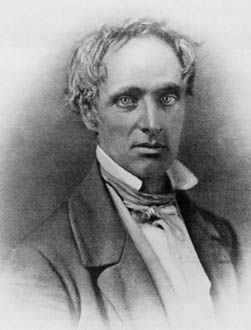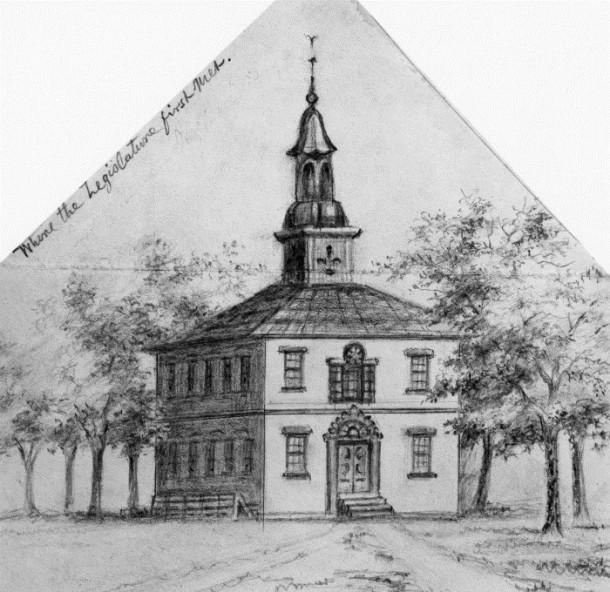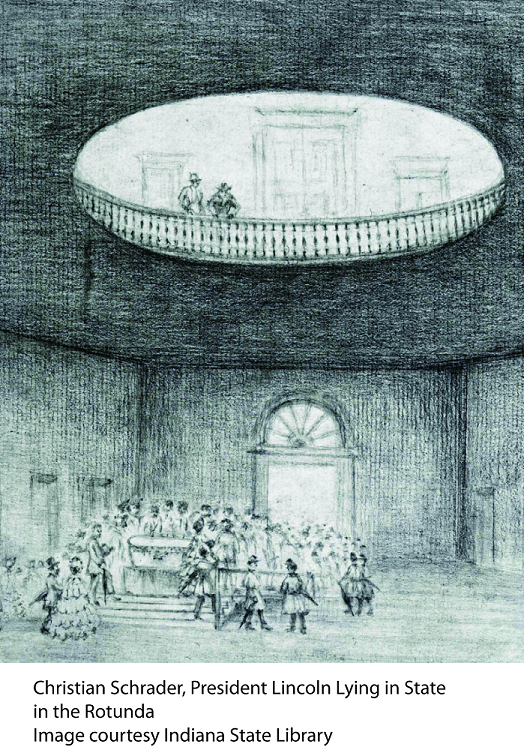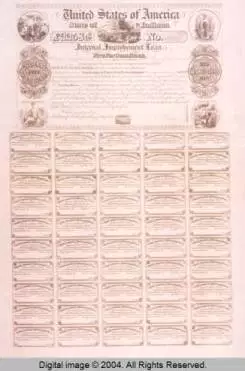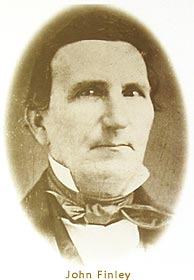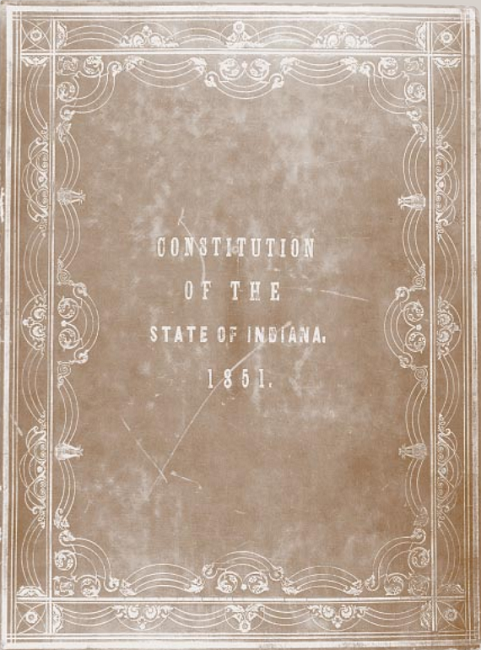
* See Part Two: Surveying, the First Statehouse, and Financial Collapse (1826-1846)
The New State Constitution of 1851
After years of political and budgetary turmoil, the Indiana General Assembly and the general public agreed that it was time for an improved state constitution. The failures of the Mammoth Internal Improvements Act in the 1830s and 1840s precipitated a need for more safeguards against “special legislation,” or local legislation that served special interests.[1] The election of state delegates, many from within the General Assembly, ensured that state debt would be contained and allowed for only special defense purposes. For example, delegate Schulyer Colfax (future vice-president under Ulysses S. Grant) wanted the language on debt to be so clear that, “no more State debt shall hereafter be created upon any pretext whatever. . .”[2] The limitations enacted against the General Assembly created a rigid political system that neglected the promise of debt remuneration for at least three decades, especially during the disastrous effects of the Civil War.
The delegates, however, did create more effective organizational tools for the legislature. The General Assembly was provided with biennial sessions with sixty-one days of legislative time, and a two-year term for representatives and a four-year term for senators were also established. Furthermore, the House and Senate were limited to only 100 and fifty members, respectively. These same provisions continue today, with the notable exception that the General Assembly now meets every year. The delegates also made some social progress, instituting a stronger push for public schools and easier access to citizenship for immigrants.[3] Yet, there was one particular provision of the new state constitution that created widespread animosity up through the Civil War.
Indiana and Race: The Antebellum Years
When the state constitution was ratified by the public in February 1851, it institutionalized its own version of racism. Article 13 stated that, “No negro or mulatto shall come into or settle in the State, after the adoption of this Constitution.”[4] Even though Indiana was a Free State, a strong antagonism towards African-Americans lingered. As historian David G. Vanderstel noted, Article 13 “demonstrated the strength of the exclusion and colonization movements, which sought to remove blacks to Africa.”[5] Voting rights for the already 11,000 African-American citizens was also prohibited by the 1851 constitution, and African-American marriages were also left unrecognized.[6] Many of these egregious policies were slowly reversed after the Civil War, but discrimination and legal obfuscations continued well into the mid-twentieth century.
Indiana and the Civil War
The Civil War permanently altered the course of the United States, and Indiana’s unique role in the conflict underscored these drastic changes. Indiana ranked second among the Union in the amount of troops, just over 197,000, and suffered over 25,000 casualties.[7] While personal sacrifices occurred on the battlefield, an internal civil war erupted between the governor and the Indiana General Assembly. The eye of this political hurricane was Governor Oliver P. Morton, often cited as Indiana’s most influential Governor. Elected as Lieutenant Governor under Henry Smith Lane, Morton assumed the governorship after Lane went the U.S. Senate.[8] From 1861 to 1867, Morton made his presence felt throughout the state, often in controversial ways.
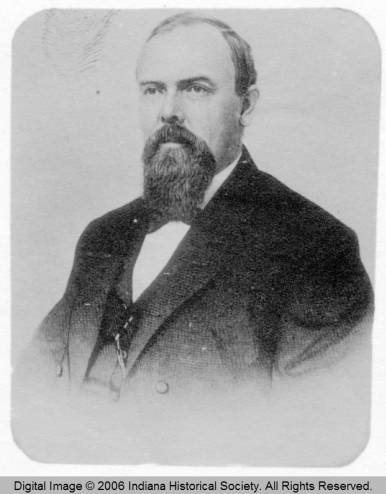
Morton’s leadership exacerbated the political divisions within the Indiana General Assembly. Some Democratic legislators scrambled to remain relevant, supporting the aims of the Union but not the executive power grabs of Morton or President Lincoln. Others were fierce “Peace Democrats,” which the Morton administration targeted as “Copperheads” and “traitors.”[9] The same divide pervaded the Republicans as well, but their leadership often bowed to Morton’s forceful demands. But by 1862, the barrage of military failures and Lincoln’s Emancipation Proclamation had angered the Indiana public enough to ensure a Democratic sweep in the mid-term elections.
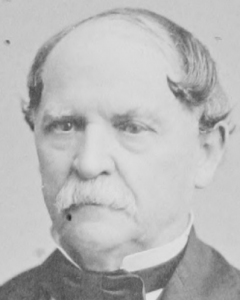
Once the Democrats had control of the state’s legislature and finances, the legislative progress of Indiana stagnated for over two years. When the General Assembly tried to pass a law that truncated the Governor’s war-time powers, the Republicans, “bolted, fleeing Indianapolis in order not to be forced to provide a legislative quorum.”[10] The finances of the state become so dire that Governor Morton, along with a consortium of bankers united by fellow Hoosier James Lanier, financed the state government by fiat, without legislative approval. At one point, Morton doled out funds from a safe in his office, virtually circumventing the General Assembly.[11] By 1864, Morton was essentially a dictator, but the cause of the Union, at least in his perspective, was larger than the need of constant legislative approval. The Indiana public largely agreed. The 1864 elections swept a wave of Republicans into the legislature, reelected Morton, and helped calm some of the storm that was Indiana’s government.
Once the war was over, Morton finished out his term and became a United States Senator. The Indiana General Assembly, by 1869, was flooded with Radical Republicans, ensuring that at least some of Reconstruction’s policies were carried out. Nonetheless, the Civil War divided the Hoosier state in ways not felt since, and Morton’s tempestuous relationship with the General Assembly certainly motivated those divisions.
Notable Legislators
- Horace Heffren
- The Civil War era was full of cantankerous characters, and State Representative Horace Heffren was no exception. In 1861, Heffren, a Democratic representative from Washington County, was accused of treason by Republican lawmaker Gideon C. Moody. Tensions grew so quickly that on February 11, 1861, Moody challenged Heffren to a duel in Campbell County, Kentucky. A Sheriff stopped them just before fatal shots could be fired and the Indiana General Assembly took no recourse against them.[12] After the attempted duel, Heffren was again tried for treason in 1864, but to no avail. Heffren was lambasted by Republicans as, “one of the most loudmouthed, rampant, bitter, boisterous, violent, venomous, poisonous copperheads that could be found on the face of the footstool.”[13] Whether or not Heffren was actually a traitor is lost to history, but the level of animus against him shows the bitter divisions within the Indiana General Assembly during the Civil War.
- Alexander J. Douglas
- The arrest and trial of Indiana State Senator Alexander J. Douglas provides us with a glimpse into the intense and polarizing era of the Civil War. Douglas, born in Ohio in 1827, practiced law and served as Whitley County prosecutor from 1859 until his election to the Indiana General Assembly in 1862.[14] With a voting public disgruntled from the heavy-handed policies of Morton, Douglas benefited from wave of votes for Democrats in the mid-term elections. As a fierce opponent of the policies of Lincoln and Governor Oliver P. Morton, Douglas used his new-found influence in the Senate to denounce Unionist policies and their “centralization” of state of power.[15] These tensions accelerated after the arrest of noted anti-war Democrat Clement Vallandigham, whose speech in Columbus, OH chastised the dissent-snuffing policies of General Ambrose Burnside. Douglas came to Vallandigham’s defense in a series of speeches denouncing the use of military arrest on civilians. Douglas was then arrested by General William Tecumseh Sherman and put on trial through a military tribunal.[16] Even though he was found not guilty of treason, Douglas’s trial illustrated the deep ideological and political divisions at the heart of Indiana during the Civil War.
See Part Four
[1] Justin E. Walsh, The Centennial History of the Indiana General Assembly, 1816-1978 (Indianapolis, Indiana Historical Bureau, 1987), 179.
[2] Donald F. Carmony, “Historical Background of the Restrictions Against State Debt in the Indiana Constitution of 1851,” Indiana Magazine of History 47, no. 2 (June 1951): 129, 140.
[3] James H. Madison, The Indiana Way: A State History (Bloomington: Indiana University Press, 1986), 138-140.
[4] Charles Kettlebrough, Constitution Making In Indiana, 3 vols. (Indianapolis: Indiana Historical Commission, 1916, 1930 [reprint edition], Indianapolis: Indiana Historical Bureau, 1971), 1: 360.
[5] David G. Vanderstel, “The 1851 Indiana Constitution,” Indiana Historical Bureau, accessed November 12, 2014, http://www.in.gov/history/2689.htm.
[6] Madison, The Indiana Way, 169-170.
[7] Ibid, 197.
[8] Ibid, 198.
[9] John D. Barnhart, “The Impact of the Civil War in Indiana,” Indiana Magazine of History 57, no. 3 (September 1961): 187.
[10] Madison, The Indiana Way, 203.
[11] Ibid, 203.
[12] Walsh, Centennial History, 189.
[13] Ibid, 190-191.
[14] Stephen Towne, “Worse than Vallandigham: Governor Oliver P. Morton, Lambdin P. Milligan, and the Military Arrest and Trial of Indiana State Senator Alexander J. Douglas during the Civil War,” Indiana Magazine of History 106 (March 2010): 6-8.
[15] Ibid, 10.
[16] Ibid, 32.

